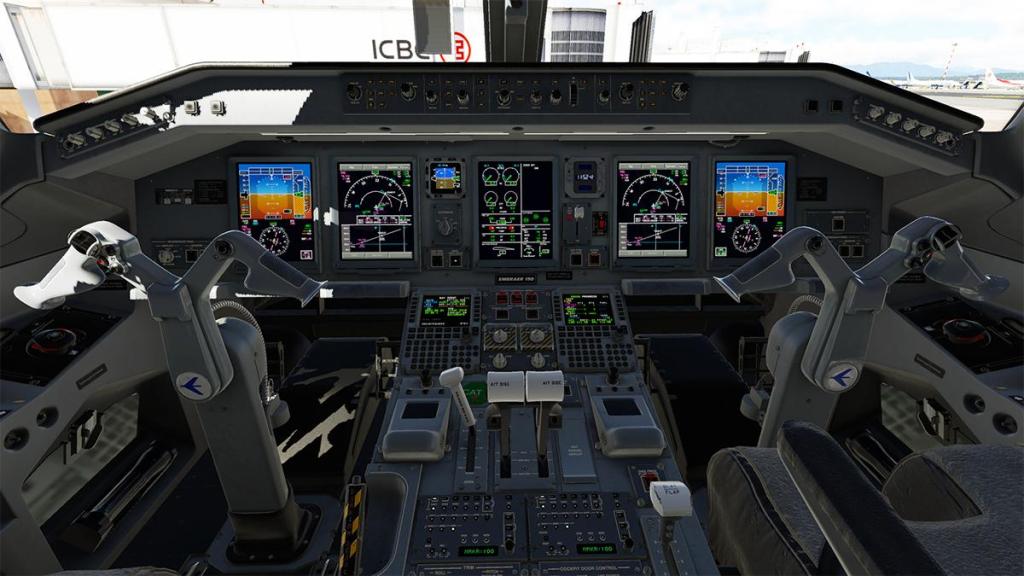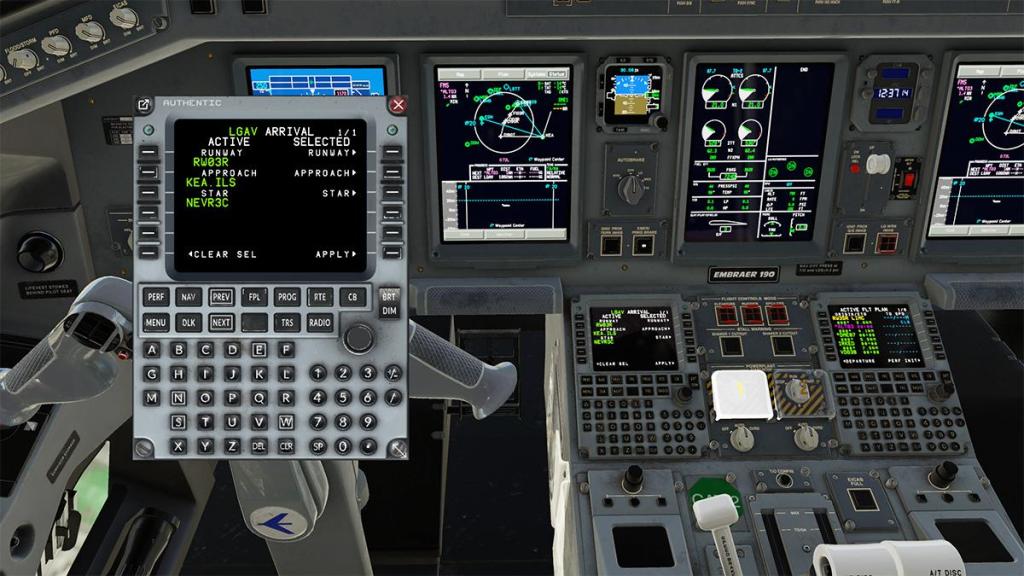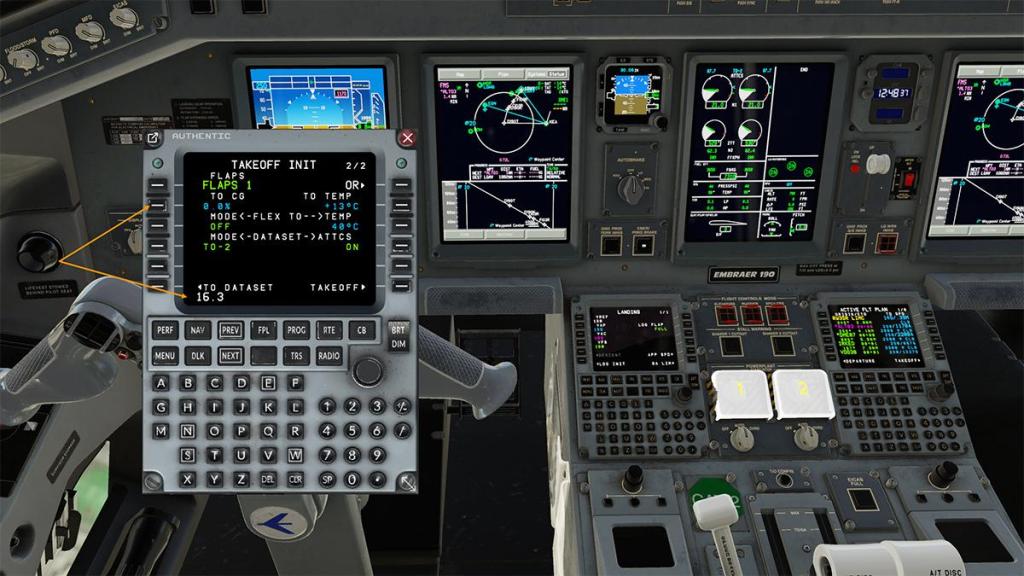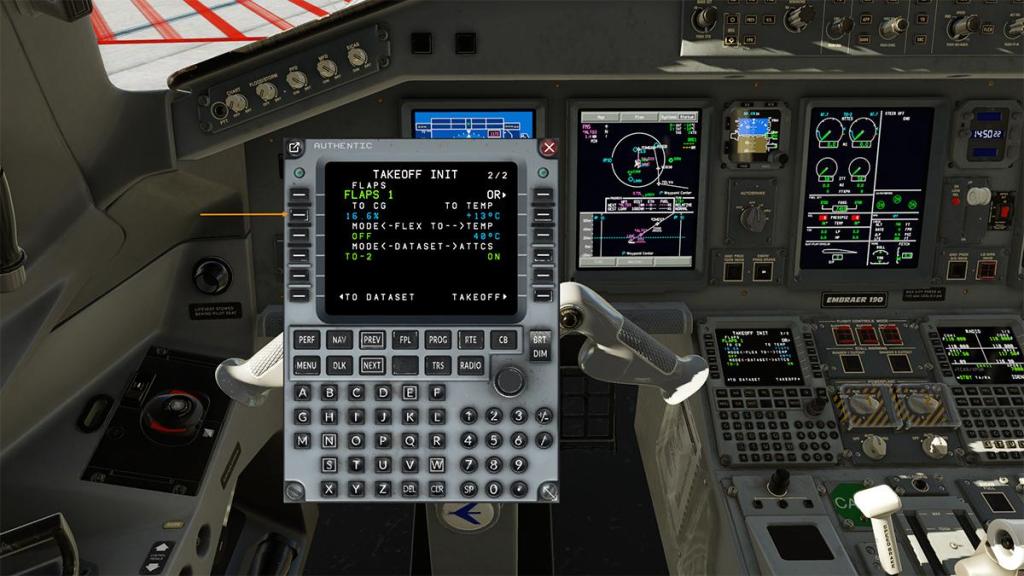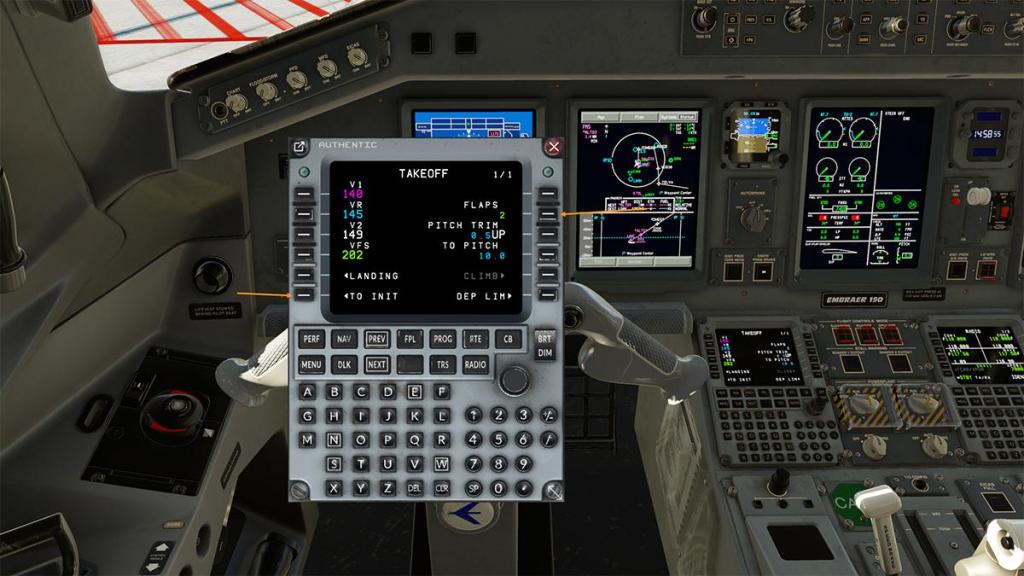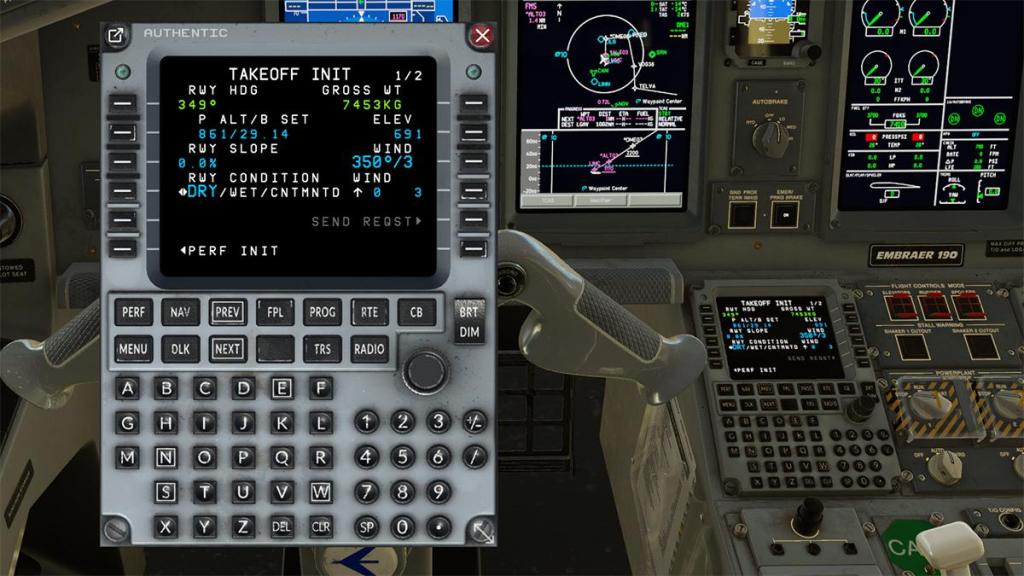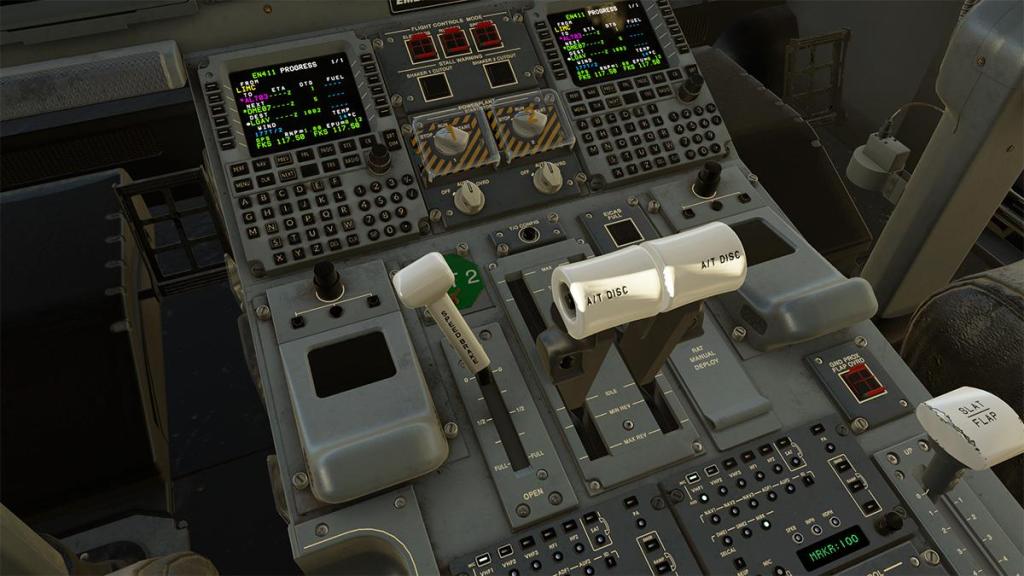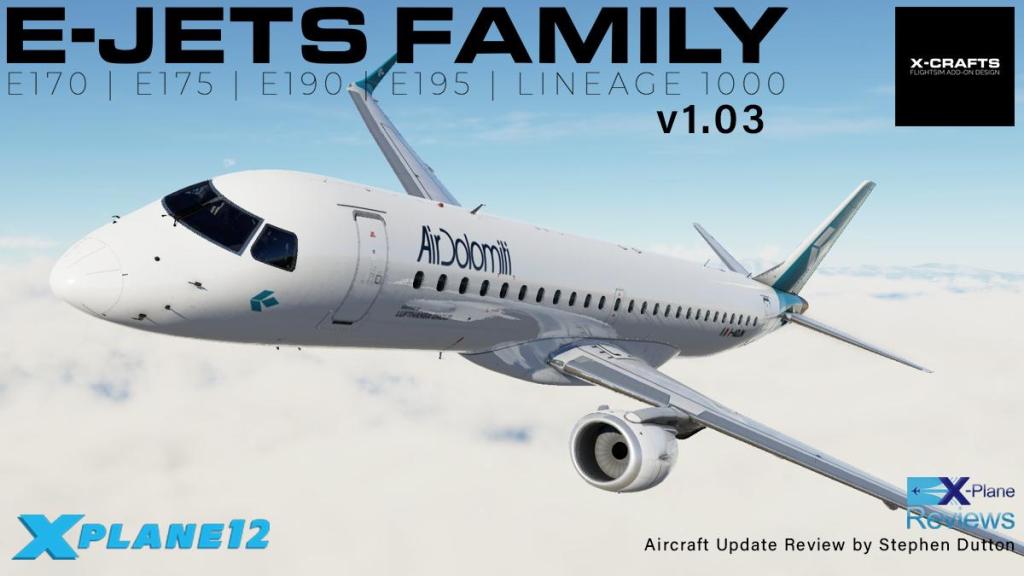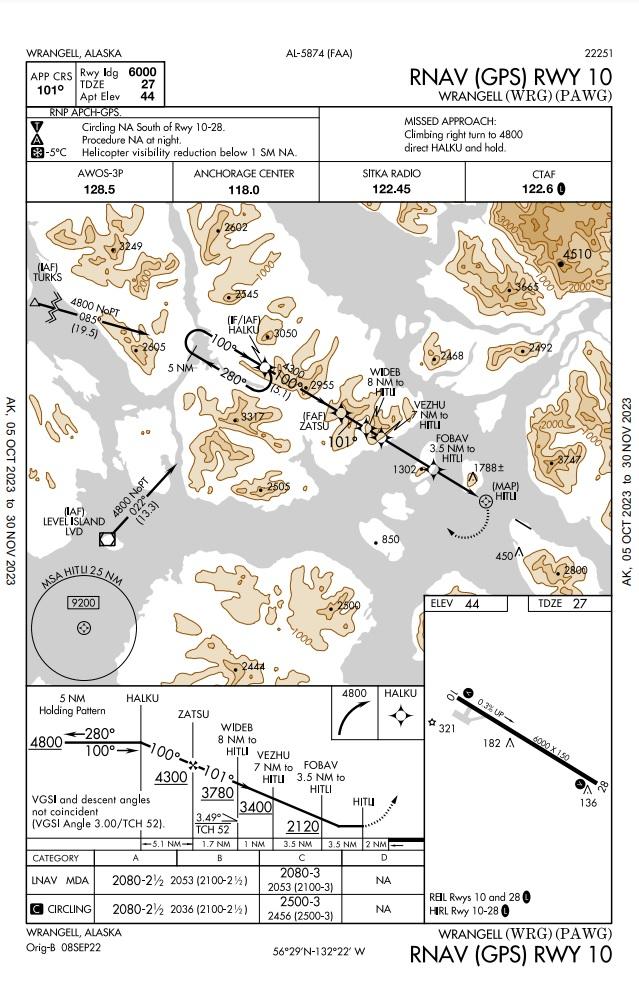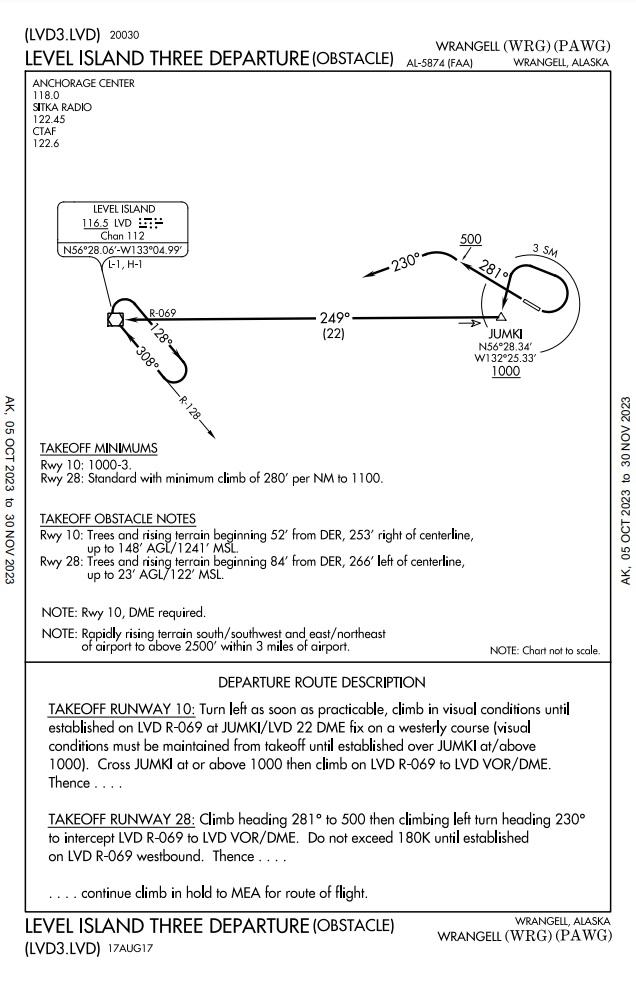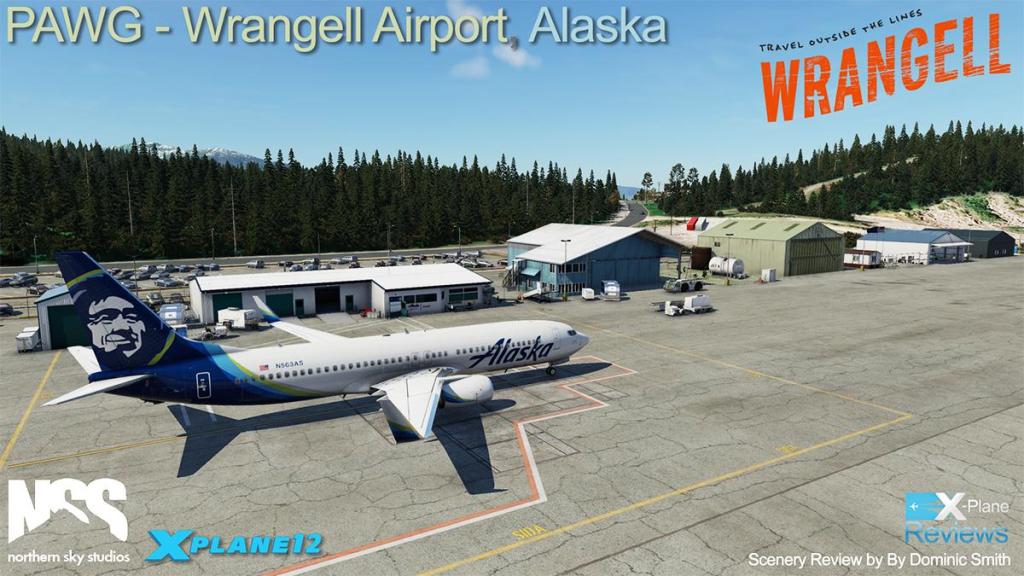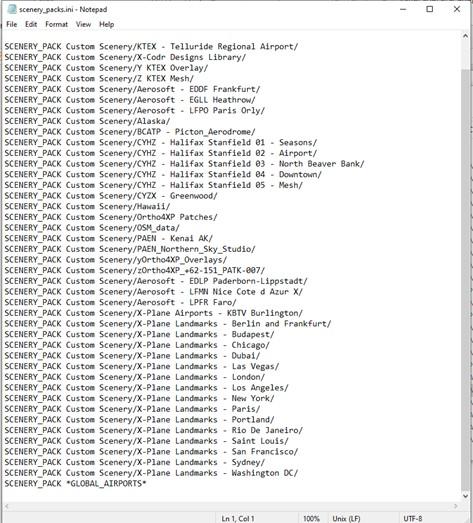Leaderboard
Popular Content
Showing content with the highest reputation on 10/28/23 in all areas
-
Aircraft Update Review : Embraer E-Jets Family v1.03 by X-Crafts Earlier this year was one of the year's most significant new aircraft releases for the X-Plane 12 Simulator. The E-Jet Family series of aircraft was released on the 10th May 2023 by X-Crafts, and obviously X-PlaneReviews did the full release review on the aircraft: Aircraft Review : E-Jets Family by X-Crafts. Release reviews are always an early in-depth look of the aircraft. Detailing the Features, Systems, Instruments and focusing on the Modeling, look and feel of the release. In this case it was a long review, because there are five different variants of the E-Jet family, four in E 170 - E 175 - E 190 - E 195 as they all were part of the release package, the fifth is the still to be released E 190 Lineage Business Jet. So it is always interesting to come back to the aircraft a few months after the initial review, to not only see the updates (fixes) on the package, but also have another perspective on the aircraft after a period of flying the machine and absorbing it's features. These update reviews are not a totally in-depth review like a few months ago, but to pick out the highlights and changes since that original release. The new E-Jet Family from Embraer in Brazil, was not the first Embraers from X-Crafts, first was the E 175 LR: Aircraft Review : Embraer E 195 LR by X-Crafts, which came into X-Plane 10 in August 2014, with then later the smaller E 175 on December 5, 2015. The difference with the 2023 release in that it was a completely different remodeling and systems redesign for X-Plane 12, and nothing on the earlier E-Jet aircraft was passed over to the new, the E-Jets also came with a significant price increase. But I found with the extremely high quality and huge feature list, it did also certainly realign the product to this new price point level, in some ways it is a remarkable achievement for X-Crafts on what they delivered. Since the release there has been three updates, v1.01 (19th May), v1.02 (26th June) and this latest update to v1.03 (October 3rd). The first v1.01 update was a reaction to release, to fix immediate bugs and issues. v1.02 was a more in-depth revision focusing on System Improvements, PFD (Primary Flight Display), MFD (MultiFunctional Display) fixes and sounds. Which brings us to the latest v1.03. This update is what you could call a mature update. All updates can be done via the excellent new Skunkcrafts Updater... and first impressions back in the E-Jet cockpit support that feeling. Those first impressions are simply "Wow", it really is superbly created. The detail and quality really does jump out at you. Remember this is really the first X-Plane 12 aircraft (in this category), created and designed specifically for the X-Plane 12 version and it's new lighting effects. And the E-Jet certainly has that extremely look and realistic feel... In the release review I flew the E-195, this aircraft is the E-190, slightly shorter (36.25 m (118 ft 11 in), less passengers, but comes with a longer range in 2,450 nmi (4,537 km; 2,820 mi) and by flying an extra 150 nm. It is still a huge cabin... galleys are small, but extremely well done. The cockpit is stunning as well, the detail is even overwhelming, even though I know it in complete detail from May. And you can slip yourself into the pilot's seat and adjust it forward. The E-Family uses the Honeywell Primus "Epic", Electronic Flight Instrument System (EFIS) glass cockpit... I really don't have a lot of negative comments with X-Crafts E-Jet Family, but there are two, or really one that can absorb the second one. The custom "Authentic" FMS is very good, yes authentic. But it is very long-winded to programme, not just the actual route, but there is a lot of performance and data to feed in. But there are helpers... On the EFB there are three pages covering Weight & Balance, Takeoff Perf and Landing Perf. You can import the Flight data from SimBrief (Simbrief ID Required), and it fills out your loadsheet, you can then use this data to "Load (the) Plane"... but it won't insert your route? The quickest way is to use the X-Plane 12 FMS flightplan (you can use the SimBrief Downloader App to insert the file in the X-Plane FMS plans folder). Then load in the route as a CO ROUTE You still have to insert your Departure and Arrival procedures, to complete the route detail. Again on the EFB, you can create the "TakeOff" and "Landing" performance data. You then have to fill in the Wind, (Airport) Temperature and Baro QNH. When computed, you can send the data directly to the FMS, via the upper right link. It is hard to find, but to set these Takeoff and Landing speeds you then have to go to the ACARS MAIN MENU, under NAV-INDEX/DATALINK. But it does not set other crucial data... one of the big annoying diversions is caused by setting the TO-CG (TakeOff - Centre of Gravity). The TO-CG is shown on TAKEOFF INIT page 2, but it won't accept the TO-CG %, as you would usually program in the Trim on the TAKEOFF page. The TO-CG is actually set on the PERFORMANCE INIT-KG page 2, then it fills in the TAKEOFF INIT (page 2) setting... it also then sets the "PITCH TRIM" and "TO PITCH", both slots you usually do manually, here it is automatic. Another diversion is to set the Takeoff flap setting. Here it is set to FLAPS 2, to change the Flap setting you go to the TO INIT lower left LK6 Select Page 2 and the Flap selection is the first row RK1... OR Then select your Flap Setting 1, 2, or 4 and the "ACT" is the active flap setting, when done press RETURN. The Flap setting change is now done on the TAKEOFF main page. More data also has to be filled out on TAKEOFF INIT, this time page 1. WIND is required RK3... Another one... back to the PERFORMANCE INIT-KG Page 2, to fill in ISA DEV, ZFW, CRZ ALT (Altitude) and CRZ WINDS. Get it all right and your FMS active FLT PLAN lights up with SPEED and ALTITUDE data. Don't get me wrong, it is a brilliantly deep FMS system, really well done. Once you get skilled at the way you programme in the data, you will be well pleased with the result... but what if you make a mistake, or your flight is tomorrow? That is the crunch... you can't save all your set up hard work, shut down the Simulator, and it's all gone. So it becomes a use it or lose it situation, and it's a lot of (programming) work to lose, and it's time consuming to reprogramme everything back in ready again. Developer note- "Use the ICAO code instead of the identifier to search for airports. This should fix some airports not being found on the EFB, If this still happens to you, then quit X-Plane, then navigate to …\X-Plane\Output\caches\xcrafts, and delete the airports.db folder. It will be recreated automatically next time you start X-Plane. And this should resolve the issue". Throttles Those lovely throttles have been troublesome since the original release of the XP12 E-Jet Family. Certainly if you have some add-on hardware throttles, like I do with the Saitek X56 Rhino. At first they didn't work at all with the Add-on set up, in v1.02 they did work, but both levers were locked together? In v1.03 the throttles now work independently of each other and realistically... nice! But there is something working even better here now, and clever as well. Reverse on these sort of "BETA" gate style throttle quadrants was always very tricky to get right with Add-on throttle systems Just try FlyJSims DASH Q4XP to see how hard it is to get it working realistically. But X-Crafts have come up with a novel solution here. Select your Reverser Mode as usual (Toggle thrust reversers), and the throttles drop back into the MIN REV gate, push up the throttle power and the throttles do the reverse action in going rearwards to MAX REV.... So simple it makes you cry, but so easy to use. Do the reverse procedure to get back to IDLE position (pull back throttles then re-toggle the reversers)... brilliant, you can play and marvel with them for hours. X-Crafts has also changed the Throttle Retarding detection method to prevent previous hardware issues, also the LNAV and VNAV will not disconnect if you disengage AP anymore. One of the biggest protestations with the release version was the aircraft would lift off the runway before the v2 (149 knts) + Rotate position was acquired. X-Crafts have done a lot of work on this issue, and it shows, at the rotation point it is now perfect, and at the correct vSpeed. Visually it's better as well with improved wingflex. So as the wings take the weight, they will bend now higher (or more realistically) on takeoff, but they don't flex in the replay mode, a Laminar bug it seems. I initially climb to 12,000ft, or 15,000ft if the airport is at a high altitude. Once there you switch off the seatbelt signs and clean up the lighting, and increase the speed (285 knts). Lately I have been comparing FLCH (Flight Change) modes in various reviews, to see how they stack up. I have in the past always been a procedures person and did all the Flight Level and Speed changes (Knts/Mach) myself. But decided to see how the E-Jet performed. And the results are impressive. Like noted I was at 12,000ft with an altitude change to FL320 (32,000ft), so I pressed the FLCH and watched it perform... The (vertical) climb was originally set at 3,200 fpm, but quickly settled down to around 2,200 per minute, then over the climb it changed the pitch feet per minute from the 2,200 - 1800 - 1600 - 1200 - and going past FL300 it was down to 800, until reaching the correct altitude. Like I said, that was sensational in the sort of climb rates I would do manually. in v1.03 there has been some adjustments on the Mach number changeover point, now 31,000 ft. The VNAV has had a lot of attention as well... first the VNAV not engaging if AP not selected before 1200ft AGL, thats now also been fixed... ... TOC is now visible if it occurs within the SID. TOC is displayed currently based on average climb performance, but you may even reach FL before or after TOC, and that is normal. Route waypoint altitudes didn't before conform to climb or descent altitude profiles when before TOC or after TOD, thats been fixed as well. Finally the Vertical deviation bug does not stay in the middle during level offs during the descents, now it does... all small stuff in being corrected, but it adds up to a very realistic Simulation. The results are impressive, in reality you can press the FLCH button (after selecting the new altitude), and climb professionally straight up to the new flight level in perfection, no dramas, with a Mach switch over on the ride up, in fact the E-Jet is fully automated, a one button press does the lot. I will note though that the FL change to my cruise altitude of FL340 (2,000ft) was a bit abrupt, 2,000 fpm was a bit excessive, but it quickly readjusted to 900 fpm, me I usually change levels around 500 fpm to 600 fpm in this category of aircraft over small altitude steps, don't want to scare the passengers. Glass transparency was debated, and the conclusion by X-Crafts was that the transparency was true to life and depends highly on the lighting conditions in the sim, that is a point... I don't think any developer can adjust cockpit lighting at the moment, it's still to transient. The one distraction I don't like is Throttle hunting. I have a nasty tailwind of 67 knots, so the Yokes are flickering and the Throttles are adjusting to the wind changes... but it's actually good here, not that abrupt movement, but a seemless casual adjustment as required, so the actions of the systems look and feel very realistic in flight. Is this E-Jet a great reflection on the state of X-Plane 12 currently, yes it is, very impressive. Rear Navigation lights are now white, from the earlier red, look nice as well... all Navigation lights have been increased in intensity of around 20%, and so have the strobe lights. Cockpit lighting is excellent, but the Autopilot glareshield controls are still very hard to read in the daylight, fine at night... but confusing in the day. FLCH descent felt a little excessive at 3,500 fpm? I would usually descend around 2,000 - 2500 fpm, only 3,000 fpm in an emergency, you press FLCH and the nose just goes DOWN... I'll do it manually. Our arrival at Athens, love it when the gear unfolds. On the E190/E195 variants, the engine pylon was going through the flap when the flaps were extended, now that is fixed, another change is that the Flap extension times were reduced after evaluating some real-world videos. Flap 1 now takes 15 sec to extend instead of the earlier 20 seconds... so quicker. Manual approach flying is exceptional, you have to be impressed on how really good Flight Simulation is today, X-Plane dynamics give you an exceptional "hands on" feel for the aircraft in "Finals". Sound changes in v1.03 are all mostly focused on the landing contact... with added cabin mains (gear) ground contact, cabin nosegear ground contact, a new cockpit mains ground contact and cockpit nose ground contact sounds. The "autobrake" warning is also now aural. One other aural adjustment was the rather noisy electric hydraulic pump by about 6dB, so the sound pitch is now down slightly. Obviously I couldn't wait to try out the better engine reverser actions, and they look and feel excellent, inside throttle actions and external. The E-Jet is fantastic and impressive as well. _________________ Summary Released to great fanfare in May 2023, is the totally upgraded E-Jet Family Series from X-Crafts. The aircraft set new standards for regional aircraft design and detail, and was the first completely new X-Plane 12 focused release, plus it went up into the upper elite category price wise. Since the release there has been three updates, v1.01 (19th May), v1.02 (26th June) and this latest update to v1.03 (October 3rd). The first v1.01 update was a reaction to release, to fix immediate bugs and issues. v1.02 was a more in-depth revision focusing on System Improvements, here we focused on the largest update yet with v1.03. A full changelog is below. The update list is long, but highlights in v1.03 include fixes for the earlier troublesome Throttle quadrant for Add-on hardware. This time the fixes are done, and with the added extra of a well designed Thrust reverser action, for the same add-on throttle systems. Aircraft dynamics relating to early runway lifting has also been attended to, in fact TOC and TOD points have also had attention with a focus on the Knts/Mach transition, lots of attention for all VNAV, LNAV, PFD, MFD elements and the EFB Tablet are also well detailed, and goes a long way to giving the aircraft a maturity it deserves. A few physical changes are done as well, Navigation rear lights are now white, and all Nav lights are 20% brighter, modeling Engine Pylon into flaps is fixed, as is the flap speeds. Sounds are focused on Cockpit and Cabin runway contact speeds, and all have been revised. This is a very complex aircraft, programming the Primus "Epic" FMS, can take time, but gets far easier with familiarity and use, but X-Crafts have done a lot to make it a realistic, if also a provided a lot of "helper" options, but the important global save is still missing, and badly needed here. The non-connection to the Tiller is still there, and the lighting is still unusual in excellent night lighting, is in contradiction to the various daylight lighting being blanked out? an X-Plane 12 issue? The Guidance Panel is still impossible to see the daylight. Every thing here with the E Jet Family from X-crafts comes down to price. The packages are set in the high quality category, a single aircraft version is priced only US$5 lower than the category leader the FlyJSim Q4XP, the full five aircraft package (the lineage coming later) is US$134.95, yes that is expensive. For the past purchaser of the X-Plane 11 v2 version, the new purchase still gets a 15% discount, if you upgrade later to the full package, then there is a 50% discount, the best deal is 15% off the full package if you are a previous owner, still a big investment, and one that runs the full life of the X-Plane 12 version. The astounding quality of the aircraft here hits you in the face, this is "Top Notch" category that easily matches the class leader in FlyJSim's Q4XP Dash 8 aircraft, but there is also that "New Gen" feel of the quality and detail that gives this series the signal that it was created and designed for the future, or X-Plane 12, and it is not a conversion aircraft of the past. In truth this is the first (in this high-level category) of a pure X-Plane 12 release, and you see and feel it, and the E-Jets still feels very new and fresh after six months of release. The E-Jet Family from X-Crafts is a standard bearer in quality and systems for the X-Plane 12 Simulator. These revisions and consistent updates are moving the aircraft very quickly to a mature standard. It's a brilliant in-depth Simulation, that shows off X-Plane 12 to it's ultimate best. _____________________ Yes! the Embraer E-Jets Family v1.03 by X-Crafts is currently available from the X-Plane.Org Store here : Embraer E-Jets by X-Crafts Price per single aircraft is US$74.95 Embraer E170 by X-Crafts Embraer E175 by X-Crafts Embraer E190 by X-Crafts Embraer E190 by X-Crafts Purchasers of the E-Jet v2 (X-Plane 11) can get this new XP12 version with a 15% discount Embraer E-Jets Family by X-Crafts Price for the FULL E-Jet Package is US$134.95 Includes every E-Type | E170 | E175 | E190 | E195 Plus + Linaeage 1000 Private jet (When Released) Purchasers of the E-Jet v2 (X-Plane 11) can get this new XP12 version package with a 15% discount Requirements X-Plane 12 or X-Plane 11 The first few initial updates will still be X-Plane 11 compatible, however, 6 months after the release, the X-Plane 11 version will be final and development will continue only on the X-Plane 12 version. Windows, MAC or Linux - 4 GB VRAM Minimum. 8 GB+ VRAM Recommended Current version: 1.03 (October 3rd 2023) Download via Skunkcraft Updater Download (Package) installed is; 5.56GB. The AviTab plugin is also required to use this aircraft, and it is deposited in your X-Plane Plugins folder. Designed by X-Crafts Support forum for XCrafts Documentation There is excellent full coverage documentation and built in checklists, including; E-Jets Family by X-Crafts - User Manual Changelog v1.01, v1.02 and v1.03 Version Notes v1.0.3.txt _____________________ Aircraft Review by Stephen Dutton 28th October 2023 Copyright©2023: X-Plane Reviews Review System Specifications: Windows - 12th Gen IS1700 Core i7 12700K 12 Core 3.60 GHz CPU - 64bit -32 Gb single 1067 Mhz DDR4 2133 - PNY GeForce RTX 3080 10GB XLR8 - Samsung 970 EVO+ 2TB SSD Software: - Windows 11 Pro - X-Plane Version 12.07r1 Plugins: JustFlight-Traffic (X-Plane.OrgStore) US$52.99 : Global SFD plugin US$30.00 : Scenery or Aircraft - LIMC - Milano Malpensa XP by Aerosoft (X-Plane.OrgStore) - US$29.95 - LGAV - FlyTampa - Athens (X-Plane.OrgStore) - US$28.00 (Disclaimer. All images and text in this review are the work and property of X-PlaneReviews, no sharing or copy of the content is allowed without consent from the author as per copyright conditions) All Rights Reserved2 points
-

Scenery Review: PAWG - Wrangell Airport by Northern Sky Studio
rudeboy1988 reacted to Dominic Smith for a topic
Scenery Review: PAWG - Wrangell Airport by Northern Sky Studio By Dominic Smith Introduction Tucked away amidst Alaska's stunning landscape, Wrangell Airport (PAWG) stands as a vital hub to the awe-inspiring natural beauty of America's wilderness frontier. Primarily serving as a general aviation terminal, this airport is an essential lifeline for the community of Wrangell. With its backdrop of rugged mountains, lush forests, and endless waterways, the airport encapsulates the raw allure that Alaska is renowned for. My first meaningful encounters with Alaskan airports, specifically Wrangell and Ketchikan, were thanks to Tom Curtis' memorable Final Frontier and Inside Passages packages. These weren't just ordinary scenery additions for me; they were the linchpin that tethered me to the X-Plane realm, even when FSX was a compelling alternative. There's something about Alaska that mirrors the untamed beauty of Scotland, albeit on a grander scale that staggers the imagination. Following their impressive release of Kenai Airport, Northern Sky Studio is back with their take on Wrangell Airport. Available for both X-Plane 11 and 12, this package aims to capture the unique charm of this Alaskan locale. But can it live up to the high bar set by their previous release? Let's dive in and find out. Installation Upon completing your purchase, you'll discover two versions of the scenery in your account—one tailored for X-Plane 11 and another for X-Plane 12, the latter being the focus of this review. The downloaded package tips the scales at just above 2.5GB, expanding to nearly 3.4GB once unpacked. Within it, you'll find two primary folders: one dedicated to the airport and another named 'terrain'. The installation procedure is as straightforward as they come, as it’s simply a matter of dragging and dropping the relevant folders into your X-Plane 12's Custom Scenery directory. For those with an eye for detail, an additional orthophoto file is available. This will add another 2.5GB to your download but enhances the area with photographic scenery. While not a requirement for this package, I also chose to install X-World America, a separate but optional download, that is recommended by the developer. Documentation The documentation that comes with this package is, to put it plainly, rather sparse. It consists of a one-page PDF that provides just the essentials; guidance for installation and a list of optional add-ons that can enhance the scenery, as mentioned above. While this minimalist guide does cover the installation basics, it leaves much to be desired for those of us who crave a deeper understanding of the airport and its surroundings. There's a noticeable absence of historical context, airport charts, or even a simple map of the area. For simmers keen on learning more about the intricacies of Wrangell Airport or seeking additional context, the provided documentation leaves a lot to be desired. If you're hungry for more information, Google is your friend for digging deeper into the history and layout of the airport. First Look Upon first glance from the skies, the scenery is nothing short of majestic. The snow-capped mountains in the distance serve as a dramatic backdrop, lending a sense of awe and scale that is hard to describe. It's an expansive landscape that truly makes you feel like a small speck in a grand tapestry of nature. The sight of the surrounding area, sprinkled with small islands near and far, evokes a sense of nostalgia. It's reminiscent of my earlier days flying through Tom Curtis' sceneries in X-Plane 9. A trip down memory lane, if you will, to simpler but happy times. The optional orthophoto download proves to be a valuable addition. Not only does it enhance the realism, but it also replaces X-Plane's default ground textures, which often fall short in conveying the proper scale, a crucial element for a scenery like this. As you make your approach, the runway extends invitingly just beyond the mainland, a captivating sight for any pilot. The surrounding ortho scenery retains its sharpness, even at low altitudes, enhancing the overall experience. Near the runway threshold, the area takes on a rustic atmosphere, marked by scattered broken trees that add character to the landscape. The custom runway textures deserve special mention for delivering a realistic look, complete with weathering effects like cracks, oil stains, and rubber marks. The carefully placed foliage along the taxiways is also well-judged, adding a touch of realism without overloading your system's VRAM or affecting framerates. Northern Sky Studio has complemented the default X-Plane signage with their own custom signs, which are crisp and easy to read. These additional signs display essential frequencies and taxiway instructions, offering pilots an extra layer of guidance. The airport also hosts a diverse range of ground vehicles, from standard fuel and catering trucks to a specially modelled fire engine. A static De Havilland Beaver, complete with an extra pair of floats, is a delightful sight, as are the animated flags, which add a lively touch to the scenery. The airport is also populated with the typical clutter you'd expect at a place like Wrangell, such as cones, bins, and ladders. Maintenance buildings and hangars are carefully modelled, conveying a good sense of realism. One hangar in particular even offers an inside look, revealing a static aircraft and various maintenance gear. The Alaska Seaplanes hut is another nice addition, as is the well-populated car park at the rear…or front, depending on how you arrived at the airport. Main Airport Building The airport's main building, much like Kenai, is the highlight of this package. The exterior has been modelled with a meticulous attention to detail, mimicking the appearance of white corrugated metal, which lends it an authentic air. Stepping inside reveals a terminal bustling with life, a feature that has become something of a signature for Northern Sky Studio. If you recall my review of their Kenai Airport scenery a few months back, the interior detail of the main airport building, was without doubt, its standout feature. Wrangell, while not quite reaching those dizzying heights, comes incredibly close. The interior is animated with 3D models of passengers and staff, adding a real sense of life and atmosphere to the building. From seating, an ATM, a drinks machine, and a wall clock to bins and a map of the "Inside Passage", every detail is accounted for. Further Afield Venturing beyond the airport, and there’s yet more to see, as the package also includes a nicely modelled representation of Wrangell's central area. Situated in the northwest corner of Wrangell Island, the urban section is another testament to the developer's attention to detail. While the ortho scenery near the airport remains impressively sharp even at low altitudes, the textures in Wrangell's urban core could benefit from a higher resolution. They tend to look a bit washed out when flying at a lower altitude, which is a bit of a letdown. However, it's worth noting that they are still a significant improvement over the default X-Plane 12 textures. For the most part, the ortho provides a good solid foundation for building placement, but it's not flawless. A few structures appear to be out of alignment or even out of place. Not a game-changer, but worth mentioning for those who appreciate the finer details. The dock area is a focal point, made even more vibrant by a container ship that adds a touch of industrial character. Around the dock, you'll find various small boats, most likely in for maintenance or storage. It's a scene that almost begs for human interaction, but which is sadly missing here. The scenery rounds off with a series of piers and jetties, each teeming with boats of various types, from luxurious speedboats to more modest wooden vessels. The addition of breakwaters adds that final touch of realism to this part of Wrangell. Night Lighting Let's get this out of the way, the runway at Wrangell is as dark as a winter's night in Scotland, staying true to its real-world counterpart. If you're contemplating a night landing, I'd advise against it, unless you fancy a game of aviation roulette! The runway may lack illumination, but the surrounding area doesn't suffer the same fate. Streetlamps dot the vicinity, casting a warm and dynamic light on nearby buildings. It's a small but impactful feature that adds depth to the night-time experience. The main airport building serves as a well-lit oasis amid the airport's limited runway lighting. The interior lighting strikes a perfect balance, as it’s neither too harsh nor too subdued. So, while night flights may be off the table, the terminal provides a cozy, well-lit space where you could comfortably pass the time, perhaps even with a good book…just not the Shining! Finishing off our night-time tour is the container ship docked at the harbour, bathed in dynamic lighting. The stern and aft are particularly well-illuminated, adding a dash of spectacle to Wrangell's nocturnal scene. While the scenery presents an inviting vista during favourable weather conditions, one can't help but ponder how different the experience would be in more adverse conditions. The contrast between a sunny summer day and the harsh realities of an Alaskan winter could be like night and day, adding layers of complexity and challenge to the flying experience. Performance Running on what I'd describe as a midrange setup, Wrangell Airport delivers a performance that's pretty much on the money. My tests showed framerates hovering between 30 and 60 FPS, and that's with most settings cranked up, except for antialiasing, which I kept at a modest 2x (though I bumped it up to 4x for screenshot purposes). VRAM consumption was well-behaved, never exceeding 7GB, even at my go-to resolution of 1440p. I did notice that as the sun dipped below the horizon, the framerate tended to linger more towards the 30 FPS mark. This isn't a Wrangell-specific issue; X-Plane 12 seems to struggle with maintaining consistent framerates during the twilight and nighttime hours. While I've seen some improvements in this department over recent months, X-Plane still needs to iron out these framerate dips during the visually demanding periods of sunset and night. Given the level of detail that this scenery offers, it’s a credit to the developer for managing to keep things as smooth as they have. Conclusion Northern Sky Studio's Wrangell Airport for X-Plane 12 is a highly commendable piece of work, offering a balanced blend of stunning aerial views and meticulous ground-level detail. The main airport building stands as a testament to the developer's skill, with an intricately modelled exterior and a bustling interior that brings a virtual slice of Alaska to your X-Plane world. While it may not quite reach the heights of their previous Kenai release, it certainly stands as a strong offering in its own right, providing an authentic Alaskan experience for X-Plane enthusiasts. The package does have room for improvement though, most notably in its documentation and some minor building alignment issues. However, these are minor gripes and should not detract from an otherwise stellar package, especially considering the low asking price. Beyond the airport, the package includes a detailed representation of Wrangell's urban core, adding value and immersion to your Alaskan flying adventures. Optional ortho imagery and dynamic lighting in this area, only go to enhance its appeal, despite some resolution limitations. In conclusion, if you're an X-Plane enthusiast with a love for Alaska, Northern Sky Studio's Wrangell Airport is a highly recommended addition to your virtual hangar. It impressively balances visual richness with performance, ensuring a rewarding flying, or even just sightseeing experience. ________________________ PAWG - Wrangell Airport by Northern Sky Studio is now available from the X-Plane.Org Store here: PAWG - Wrangell Airport Priced at $16.95 Features Both X-Plane 12 and X-Plane 11 versions included The most detailed replica of airport buildings and vehicles EDGE, REIL and Taxiway lights can be enabled on 122.600 COM1 Custom hand-placed autogen High resolution ground textures / Custom runway textures High resolution building textures Compatible with all X-Plane 12 features Custom mesh for the airport area (Ortho4XP) All materials created for full PBR Shading and occlusion (texture baking) effects on all airport buildings High-resolution building textures Custom orthophoto for the airport and surrounding areas World Traffic 3 compatible Not compatible with a default mesh Requirements X-Plane 12 or X-Plane 11 Windows, Mac, or Linux 8 GB+ VRAM Recommended Download Size: 2.7 GB Current version: 1.0 (October 16th, 2023) Review System Specifications Intel i5 10400 – 32GB RAM - Nvidia Asus RTX 3060 – Windows 10 Home 64 Bit __________________________________ Scenery Review by Dominic Smith 25th October 2023 Copyright©2023: X-Plane Reviews (Disclaimer. All images and text in this review are the work and property of X-PlaneReviews, no sharing or copying of the content is allowed without consent from the author as per copyright conditions).1 point -

Scenery Review: Telluride Regional Airport UHD by X-Codr Designs
RobdeVries reacted to Dominic Smith for a topic
Scenery Review: Telluride Regional Airport UHD by X-Codr Designs By David York Introduction I'm delighted to bring you this review of XCodr Design's Telluride Airport scenery package, designed specifically for X-Plane enthusiasts. While the focus of my comments is on the X-Plane 12 rendition, it's worth noting that the scenery also performs well on the available X-Plane 11 version. Situated at a soaring altitude of 9,070 feet atop Dove Creek Mesa, Telluride Regional Airport (TEX) holds the distinction of being the highest-elevation commercial airport in the United States. Covering an expansive 542 acres, the airport features a single runway—TEX 9/27—which has an asphalt surface and dimensions of 7111 feet in length by 100 feet in width. Known for its challenging landings due to fierce mountain winds, especially in the winter, this runway is both one of the most dangerous and most beautiful to land on in America, according to Uncover Colorado. The surrounding terrain itself exceeds elevations of 14,000 feet. The landscape at either end of the runway is equally dramatic. Off one end, the terrain plunges a sheer 1,000 feet down to the St Miguel River in the valley below. At the opposite end, the terrain rises steeply, culminating in the sloping meadow that houses the Telluride Mountain Resort. A softer, engineered stop has been installed at the base of this slope to prevent serious runway excursions. Since its initial planning by the City of Telluride back in the seventies and its opening in 1984, Telluride Airport has been a collaborative venture between the tourist industry, as well as federal and local governments. Owned and operated by the Telluride Regional Airport Authority, the airport boasted 9,412 operations in 2019 and is home to twenty-seven based aircraft. It is primarily served by Denver Air Connection, offering scheduled daily flights to Denver, Colorado, and Phoenix, Arizona. Additionally, there's active charter traffic, with at least five Charter Services available. Finally, general aviation use is not only busy but also enthusiastic, making it a source of pride for those who fly out of Telluride, as per Business View. Why this Scenery? For those who relish day-to-day challenges, flying in the mountains is hard to beat, and Telluride, as a winter destination, promises the kind of excitement and realism one could desire in a flight simulator experience. As someone who has been a skier, the nostalgia of the ski slopes adds another layer of attraction for me. Despite now living in the south, I find myself yearning for the sight of ski runs and fresh powder, especially when I can experience it without the financial burden usually associated with it. Though it's not quite the same as landing in Nepal, the approach to Telluride's plateau-based airport offers a unique character that you won't find in eastern U.S. destinations. If you opt for an autopilot landing, you may even get a glimpse of the canyons below—but be warned! You'll need to stay alert for sudden wind changes and other environmental factors. Installation The scenery pack you'll need is titled 'XP12_Telluride Regional Airport Package.zip,' or its XP11 equivalent if that's your target system. The file size is a mere 2.98GB, but once installed, it will occupy over 7 gigabytes on your hard disk. This doesn't include the 'Living Scenery Technology' plug-in that is also required. The main archive is specific to Telluride and its surrounding areas, featuring the Regional Airport, the town, and resort areas. If you're new to Xcodr Designs, you'll also need to download the Xcodr Library, available in versions for both XP12 and XP11. The 'Living Scenery Technology' plug-in is essential for Xcodr products and can be downloaded from X-Plane.org. Install this plug-in in your X-Plane plug-ins directory, which you'll find in your base X-Plane directory resources folder (<X-Plane Root Folder>/Resources/Plugins). Unzip and copy the X-Codr Designs Library folder into the Custom Scenery Folder/Directory of your chosen X-Plane version. Extract the three scenery folders from the 'XPnn_Telluride_Regional_Airport_Package.zip' into the Custom Scenery directory folder. These folders are Telluride_Regional_Airport_Z_Mesh, Telluride_Regional_Airport_Y_Overlay, and Telluride_Regional_Airport_Ski_Lifts. This archive also includes your Scenery Manual. A quick note for new users: don't forget to check the 'scenery_packs.ini' text file to ensure the order list is correct. All scenery, particularly the airport, should be listed above the 'Global Airports' entry. The overlay and mesh files, in this case: SCENERY_PACK Custom Scenery/Telluride_Regional_Airport_Y_Overlay/ SCENERY_PACK Custom Scenery/Telluride_Regional_Airport_Z_Mesh/ should generally appear towards the bottom of the list but can be placed either above or below the global airport’s entry. If you have old scenery from previous installations of this package, make sure to delete them; otherwise, they may be overwritten as they bear the same name. Once you're done with these steps, no further activation is required. Just load up your version of X-Plane, and Telluride will appear in your list of available airports. Although the installation process involves quite a few steps, they are pretty standard for any scenery setup. That said, it's worth noting that the developer could have provided a small script to automate what can be a tedious and error-prone process, making for a more seamless installation experience. Documentation The documentation that comes with the package is concise, providing all the essential information you need to get started. While it does contain some outdated information, such as references to Great Lakes Airlines, which ceased operations in 2018, it's mostly current, spotlighting Denver Air Connection as the main scheduled service. The provided manual offers a succinct yet insightful introduction to both Telluride and its regional airport. They even include advice that Telluride isn't a destination for novice pilots, serving as a helpful caution and an exciting challenge for those with more experience. Some simmers might appreciate more narrative details for a richer understanding of the area, an addition that could also serve as a clever marketing strategy. Though the documentation does an excellent job of outlining the package's features, it could be enhanced by visuals like charts, graphics, or FAA airport diagrams. Such additions would provide a more comprehensive guide to the Telluride experience in X-Plane. In summary, the documentation is practical and to the point, providing the essentials for starting your Telluride journey in X-Plane while leaving room for enrichments that could make it even more user-friendly. Exploration Walkthrough Flying in this scenic area comes with a number of caveats—such as wind, obstructions, and altitude—that make it different from taking off at sea-level. Factors like fuel-air mixture and take-off distance will need to be adjusted accordingly. For those interested in the specifics, this type of operation is often referred to as 'Mountain Flying.’ As you prepare for landing, you're greeted with an awe-inspiring spectacle. Several plateaus are visible in the middle distance, the San Miguel River meanders in the valley below, and the Telluride Mountain Village is straight ahead, with rugged mountains continuing to rise beyond. The Ortho scenery is absolutely breathtaking and amplifies the simulation experience immeasurably. Take note of the moderately high fence at the edge of the plateau, your touchdown point needs to be clearly visible; there's no room for mistakes on this runway. Once you touch down, you'll taxi toward a rather modest set of well-modelled structures, including the terminal. It's a fair taxi distance to the ramps at the opposite end. Upon reaching the taxiway entrance, you proceed to either the gate area or a parking spot. Once you shut down your aircraft, you can indulge in a 360-degree sweep of the scenery; mountains surrounding you and the Telluride Resort above in the distance. The terminal itself is compact yet well-placed, with the public entrance situated conveniently above and to your right, just behind a wire boundary fence. While the interior of the terminal isn't modelled, the external details make up for it to some extent. For those accustomed to more detailed offerings like those found at Kenai, AK, this might be an area where future updates could add value. In terms of accuracy, the detailing around the terminal largely aligns with what one might observe through Google Earth. For instance, the larger entrance roadway into the main parking lot adds a touch of realism. Features like the mailbox and dumpster further contribute to this effect, although additional signage could provide an extra layer of authenticity. Outside, you'll find a paved area surrounded on three sides by well-presented hangars and other outbuildings. The textures used in the modelling are professional and offer excellent detail, complete with visible wear and tear. Up the hill behind the hangars, you'll notice a large fuel bunker by the access road—a nice touch! The airport is populated with static aircraft, attesting to the activity in general aviation, but the presence of charter services is less prominent than one might expect from a Google Earth survey. As you venture away from the airport, the quality of the provided ortho scenery becomes increasingly apparent, justifying the data investment. The animated, operational ski lifts contribute significantly to the overall immersion, offering a dynamic element to the setting. The vista from the lodge is nothing short of breathtaking. While the view does lose some of its impact if you turn around inside the lodge, this minor detail hardly diminishes the overall splendor of the landscape. The town, hidden in the valleys beyond the runway and plateau, is artistically well-done. You have to venture to the edge of the plateau to get a proper view of the artistic presentation of the town and streets. Switching to a winter setting in the simulation adds even more detail; the ski hills are more prominent in the snowfall, and both the apron at your feet and the mailbox at the back of the terminal receive a nice covering of snow. Night Lighting As dusk turns to night, the sky is graced with a beautiful red hue from the setting sun, set against a broken layer of stratus clouds above. The existing signage, limited as it is, becomes more prominent and readable once illuminated, enhancing its realism. The runway lights add the essential touch of authenticity for a winter night. In the distance, all the ski runs are lit up, lending the entire view a high degree of believability. It's evident that no detail has been overlooked in the simulation of Telluride. Scenery & Aircraft Performance Navigating the valley revealed some frame rate challenges, likely due to my hardware limitations. This suggests that those with higher-end graphics hardware will be able to fully appreciate the scenery's intricate details. In terms of aircraft performance, adjustments to fuel-air mixture and take-off distance could add an extra layer of realism, enhancing the high-altitude experience. While I'm not a qualified pilot, these observations aim to enrich the flying experience. The immersive wind and traffic sounds notably elevate the overall simulation. Conclusion Telluride Airport by X-Codr Design really is a feast for the eyes, boasting high-quality modelling and artwork that make the download size well worth it. While there's room to elevate the experience further, such as adding interior details to the terminal or enhancing the representation of charter services, these are opportunities for growth rather than shortcomings. The developer's emphasis on scenic beauty truly shines, providing a visually stunning experience that is a joy to explore. Enhancements in the business and commercial aspects could add another layer of depth, particularly in the context of an active resort area. Such additions would only elevate what is already a compelling simulation experience. What stands out the most is the package's performance on even modest systems, along with the inclusion of useful plug-ins and libraries. These features, coupled with the sheer joy of flying in the Colorado mountains, make this package a fantastic experience that can be enjoyed year-round. In summary, this package already offers an immersive and visually stunning experience, and with a few more touches, it could reach new heights of simulation realism. ________________________ Telluride Regional Airport UHD by XCodr Design is now available from the X-Plane.Org Store here: Telluride Regional Airport UHD Priced at $21.95 Features Highly detailed and realistic rendition of Telluride Regional Airport Ultra-detailed, high-resolution buildings Ultra-detailed, high resolution ground textures Lots of airport clutter, i.e. baggage cart, chocks, tie down cables and tires, etc. Integration with X-Plane 12 weather effects Accurate taxi routes, airport flows, and ramp starts Detailed rendition of nearby Mountain Village Ski Resort Animated gondolas and ski lifts using Living Scenery Technology Custom model of all major hotels Custom ski resort homes Night lit ski routes (visible from the airport and when in the pattern) Animated 3D skiers using Living Scenery Technology Custom Ortho4XP Mesh realistic runway slopes Thanks to Oscar Pilote for creating the amazing tool Ortho4xp) Custom overlay scenery based off Alpilotx’s UHD Mesh V4 scenery (used with his permission) Requirements X-Plane 12 or X-Plane 11 (both versions included) Windows, Mac, or Linux 4GB VRAM Minimum. 8Gb+ VRAM Recommended Download size: 3GB. Current version: XP12 - September 6th, 2022 XP11 - 1.51 (July 4th, 2019) Review System Specifications AMD FX-8350 - 16GB - AMD Radeon RTX 570 8GB - Windows 10 Pro 64 Bit __________________________________ Scenery Review by David York 27th October 2023 Copyright©2023: X-Plane Reviews (Disclaimer. All images and text in this review are the work and property of X-PlaneReviews, no sharing or copying of the content is allowed without consent from the author as per copyright conditions).1 point















